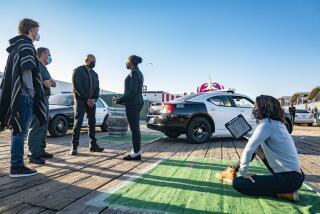12 Californians given USA fellowships
- Share via
Twelve Californians are among 50 artists, writers and other creative figures to land $50,000 each in the first round of awards from an ambitious new fellowship program called United States Artists.
The nationwide, Los Angeles-based program, created last year with $20 million from the Ford, Rockefeller, Prudential and Rasmuson foundations, aims to boost creativity by giving artists a year’s respite from financial concerns. Executive Director Katharine DeShaw said the group plans to give at least 50 awards every year, focusing on creative people whose lives would be substantially changed by $50,000.
For the record:
12:00 a.m. Dec. 7, 2006 For The Record
Los Angeles Times Thursday December 07, 2006 Home Edition Main News Part A Page 2 National Desk 1 inches; 40 words Type of Material: Correction
Honored artist: A story in Tuesday’s Calendar section about fellowships awarded by United States Artists identified Los Angeles sculptor Anna Sew Hoy as a winner and referred to her on second reference as Hoy. Her last name is Sew Hoy.
The first batch of winners, announced Monday, varied from the young and obscure -- 26-year-old Oklahoma filmmaker Sterlin Harjo, for instance -- to already well-decorated figures such as Los Angeles artist and UCLA professor Catherine Opie and Ali Akbar Khan, an 83-year-old India-born string musician (now a resident of San Anselmo) who won a MacArthur “genius” grant in 1991.
“I’ve never had $5,000 before,” said Anna Sew Hoy, 30, sculptor in L.A. who was among the winners. “I feel like I have freedom for a year, and if I’m careful, I can stretch it to two years.”
“You never really expect to win,” said Tanya Aguiniga, 28, a Los Angeles furniture designer.
Aguiniga, an alumna of the Rhode Island School of Design who grew up crossing the Tijuana-San Diego border daily, said she hopes to spend her fellowship funds on research to see how better contacts with U.S. markets can bring new vitality to traditional craft forms worldwide that are in danger of dying.
The winners’ disciplines include visual arts (12 winners), literature (nine), theater arts (seven), media (six), crafts and traditional arts (six), music (five), dance (four) and architectural and design (one).
In addition to Khan, Opie, Hoy and Aguiniga, the Californians include: Mark Bradford, a visual artist from Los Angeles; Natividad Cano, a musician from Los Angeles; Sam Durant, a visual artist from Los Angeles; Arline Fisch, a jewelry designer and metal artist from San Diego; Marc Bamuthi Joseph, a performance artist from San Francisco; Alonzo King, a choreographer from San Francisco; George Kuchar, a filmmaker from San Francisco; and Phillip Rodriguez, a documentary filmmaker from Los Angeles.
DeShaw said she and her board began by soliciting 362 nominations from 100 arts experts nationwide. Three hundred of the nominated artists followed through with applications, and the winners were chosen by panelists recruited by USA and approved by the USA board.
The organization, founded in September 2005, aims to boost support for creativity at a time when government arts grants are flagging. Though it made its announcements at Lincoln Center in New York and drew almost all of its seed money from the New York area, DeShaw said the organization plans to keep a close eye on California artists.
During the last few months, she said, the group has raised an additional $2.5 million, including $1 million from Minneapolis-based Target Corp. and $500,000 from Los Angeles arts patrons Eli and Edythe Broad, which will cover 10 “USA Broad” fellowships during the next two years.
As for how the grants will be spent, there are no strings. The sculptor Hoy said she planned to quit one of her two day jobs and buy a kiln, “so I can fire whenever I want.”
Also, she said, “I make sculptures from beer cans. Specifically, Sapporo beer cans -- those 22-ounce tall boys -- because they’re really strong. But before I make the sculpture, the beer cans have to be empty. So when I buy the Sapporo in bulk, I throw a party.”
The parties, Hoy said, are a part of her work, a responsibility-free spell during which people can talk about art and enjoy a little sense of community. “So now I can buy more beer,” she said. “And have more people over.”
*
More to Read
The biggest entertainment stories
Get our big stories about Hollywood, film, television, music, arts, culture and more right in your inbox as soon as they publish.
You may occasionally receive promotional content from the Los Angeles Times.











